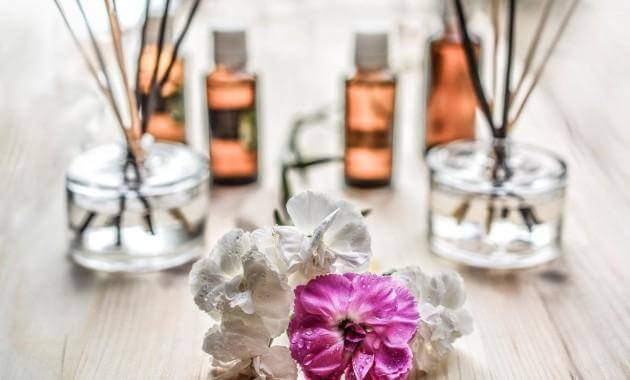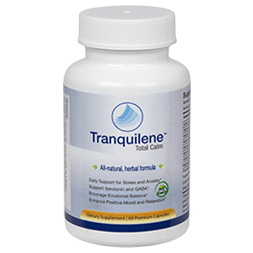Aromatherapy is more than just a buzz word you see on bath shop banners. It’s an actual science with years of studies to back up its benefits. While the aromatic chemicals in plants have long been used by our ancestors, it wasn’t until the early 1900s that suspicions of their benefits were confirmed. Highly-concentrated molecules in plants have a profound impact on the system that brings a litany of benefits.
One of the greatest benefits of aromatherapy is stress relief. This is why the use of essential oils has become commonplace in massage parlors, spas and cosmetics. Using essential oils is an all-natural way to inhale the stress away. Let’s take a look why aromatherapy and these five essential oils may be the answer to your stress problems!
History of Aromatherapy
The practice of aromatherapy has been unknowingly integrated with the human race since the beginning of time. When our ancestors first discovered fire, they started heating up surrounding plant life.
As we have learned since then, heat causes stress on physical matter. When you heat something up, the pressure changes the chemical composition of the object. Consequently, applying this exertion onto a plant will change the way it interacts with the body.
Back in the day, ancestors bit orange peels to fight scurvy. They seeped lavender into water to make sleepytime tonics. Others would crush garlic and mix the allium with honey to make a cold remedy. However they went about creating these remedies, there was one common denominator. Our ancestors need to apply pressure on the object to activate its therapeutic properties.
What caused this relief was an unknown mystery to our ancestors. However, the science behind aromatherapy all came to light in 1910. French chemist René-Maurice Gattefossé was crafting a perfume in his laboratory. Unfortunately for Gattefossé, an explosion caused the chemist to develop a case of gas gangrene on his hand.
After the explosion, the French chemist sought relief. Looking to submerge his burning appendage into something cool, he placed his hand into a barrel of lavender oil. Gattefossé wrote of the experience in his 1937 book, Aromathérapie. He recalled, “Just one rinse with lavender essence stopped ‘the gasification of the tissue.’ This treatment was followed by profuse sweating, and healing began the next day.”
Since that fateful day, we have learned that exerting pressure on plants cause them to release chemical compounds into the atmosphere. These molecules are the brainchild behind the science that Gattefossé dubbed, Aromathérapie. Today, we know it as aromatherapy, and we now have the science to confirm how it works.
What Give Plants Therapeutic Powers?
Plants are like humans in that they are unique living beings. Every plant is comprised with a number of molecules that give each being their distinct characteristics. Much like a darker skinned person may have more melanin than a lighter skinned human, plants have different quantities of vitamins and minerals.
For instance, tomatoes have a high level of the compound lycopene. This is why these fruits have such a vibrant red color. Whereas, spinach has an abundance of chlorophyll. Due to high concentrations of these compounds, spinach has a green hue.
As you can see, different plants have different molecules that give each plant its therapeutic benefits. You can tell just by looking at a plant’s color … or by smelling its aroma.
A plant’s aroma comes from a complex set of compounds known as terpenes. Terpenes are a product of evolution. In order for plant species to ward off predators, every plant on earth today has developed scents specifically targeted to repel those who prey on them.
To make it even more complex, these plants also developed scents that were attractive to pollinators such as bees … and humans. Therefore, plants developed terpenes over time that not only stopped animals and bacteria from destroying the species, but coerced pollinators to spread the plants’ seeds.
How Aromatherapy Works
Think of the smell of Grandma’s fresh baked cookies. Does this memory bring a smile to your face? That is aromatherapy at work.
When terpenes are released into the atmosphere, the molecules enter our nasal cavity. This area is home to a complex system known as the olfactory bulb.
The olfactory bulb serves as a toll both for the brain. Neural tissues in the nasal cavity interpret messages from the essential oils. The brain receives these messages, triggering a response appropriate to the essential oil you inhaled.
Just as carrots provide you with more vitamin A than a steak, each essential oil also comes with their own benefits. That is why some essential oils may be more effective in combating stress than others. Let’s take a look at some of the best essential oils to curb your bouts with stress.
Top 5 Essential Oils for Stress
As we said before, not all essential oils are made equally. While many have a load of health benefits, some oils are more effective in certain arenas than others. Therefore, if you’re looking to use aromatherapy for stress relief, be sure to incorporate these 5 essential oils into your regimen.
- Lavender Essential Oil
The one that started it all! If lavender essential oil can ease the mind of a man fighting gangrene in the 1910s, just imagine how it can calm your stress hormones. Studies of lavender oil have shown that this essential oil has a calming effect on the body.
That is because the olfactory bulb is closely entwined with the limbic system. The limbic system is home to the amygdala and hippocampus. These are areas of the body that regulate how we react to the memory of certain scents.
Mitral cells in lavender oil have shown they can bypass areas of the limbic system that other chemical compounds cannot. Therefore, the therapeutic agents in lavender oil can cause sedative-like effects more efficiently than many other chemical compounds. This is what makes lavender such a great sleep-inducing essential oil.
- Rose Essential Oil
What makes rose essential oil so unique is one of its primary compounds, nerol. Studies with neroli have shown that this chemical has a strong impact on our stress levels. This is especially true for women combating stress related to menstrual issues.
One study, in particular, was conducted with 63 postmenopausal women. Half of the women inhaled neroli oil twice a day for five days. The other half inhaled a control of almond oil. Results found that compared to control groups, those who inhaled neroli experienced:
- Increased sexual desire
- Lower blood pressure
- Improved pulse rate
Together, all of these benefits gave peace of mind to a demographic of women under otherwise intense physical stress.
- Bergamot Essential Oil
This is the orange’s spicier relative. Bergamot is used to enhance many fragrances. However, it should be used to enhance your state of mind, too.
Studies of bergamot have found that this essential oil can have a profound impact on mental health. That’s because chemical compounds within this citrus fruit help facilitate the growth of two pivotal neurotransmitters — serotonin and dopamine.
When we are under constant stress, our body produces a hormone known as cortisol. Cortisol causes the anxious feelings of overwhelming dread that comes with stress. As stress becomes chronic, more cortisol is created. In turn, the body has less room to create dopamine and serotonin.
As compounds from bergamot enter the system, it triggers the production of these calming neurotransmitters. Consequently, your body no longer feels the need to create cortisol. Therefore, feelings of stress subside. By diffusing bergamot every day, you can stall your body’s cortisol production and start the day off with a balanced field of hormones.
- Chamomile Essential Oil
Is any flower more synonymous with calmness than chamomile? While chamomile has been known to ease tensions in the body, it can also be quite energizing.
One of the worst side effects of stress is a lack of focus. We become wrapped up in our thoughts. Due to these crippling realizations, our productivity levels may tank.
With chamomile essential oil, you can turn off that naggy voice in the back of your head. At the same time, you can also redirect your focus on the task at hand. Chamomile helps you feel relaxed without compromising your focus. This makes chamomile essential oil a great tool for fighting the workday blues.
- Lemon Essential Oil
Speaking of energizing … when life hands you lemons, make lemonade! It’s hard not to look at the bright side when you’re talking about something as chipper as lemon essential oil.
This citrus fruit is high in a chemical compound known as linalool. Studies on linalool have found that this compound has a significant impact on how we perceive stress.
Stress can be triggered by hundreds of different neurons. Luckily, studies confirm that linalool helps normalize hundreds of genes that “go into overdrive” and create bouts of stress.
How to Use Essential Oils
Now that you understand the science behind aromatherapy, it’s time to implement essential oils into your everyday life. Luckily for you, there are many ways to do that. The simplest is by adding a few drops of oil and some water into a diffuser. That way, the essential oils are shot into the atmosphere at timed intervals. This allows you to reap the benefits of the essential oils while cleaning the air in your room!
If you don’t want to use a diffuser, you may be able to apply some essential oils directly to your skin. However, essential oils are highly concentrated. Therefore, some blends may have an adverse reaction to your body. Be sure to read the label thoroughly and test out the oil on a small, conspicuous spot. If you don’t have any adverse reactions, add a few drops to a roller and apply to your temples in time of stress.
You can also mix your essential oils in with thicker oils to make a lotion. There are many vegetable and fruit oils that will act as a shield between your skin and the highly-concentrated oils. For the best results, try mixing your essential oils with bases such as:
- Jojoba oil
- Sweet almond oil
- Avocado oil
- Extra virgin olive oil
- Grapeseed oil
Lastly, essential oils are perfect additions to any bath. After a long day, add 10-20 drops to a lukewarm tub full of water. From there, soak your body, close your eyes, and let the stresses melt away.
Using Aromatherapy to Combat Stress
Fighting stress can be as easy as taking a deep breath. Terpenes found in essential oils have been providing relief to humankind since our ancestors first scoured the earth. Now we have the science to prove what they knew all along. Aromatherapy can go a long way in helping us fight stress.
While aromatherapy is effective, it can stand to have a little assistance. To stop letting stress get the better of you, try supplementing your essential oils with another natural remedy. Turn to products like Tranquilene.
Much like the science behind aromatherapy, Tranuqilene uses all-natural ingredients that have shown success in fighting stress and anxiety. By combining Tranquilene and essential oils, you are giving your body a natural defense mechanism against that pesky hormone, cortisol!
Do you have a favorite essential oil blend you use to combat stress? Share your faves in the comments below!

















